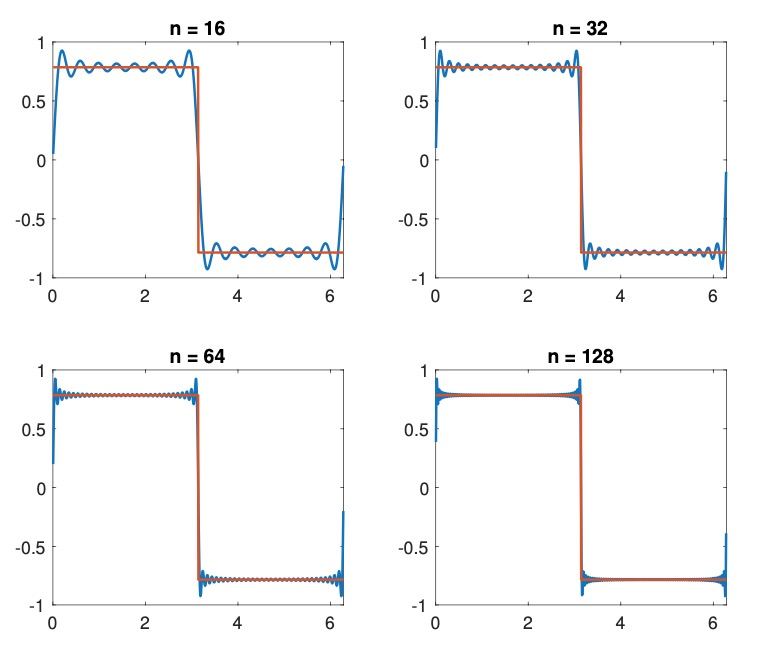January 4, 2018

In this post, I talk about a fascinating subject: the convergence of Fourier series and the Gibbs phenomenon.
Periodic continuous functions \(f\) of bounded variation have a unique and uniformly convergent Fourier series, that is, the partial sums $$ f_n(\theta) = \sum_{k=0}^{n}a_k\cos(k\theta) + \sum_{k=1}^{n}b_k\sin(k\theta), $$ with Fourier coefficients $$ a_k = \frac{1}{\pi}\int_0^{2\pi}f(\theta)\cos(k\theta)d\theta, $$ and $$ b_k = \frac{1}{\pi}\int_0^{2\pi} f(\theta) \sin(k\theta)d\theta, $$ converge uniformly to \(f\). (Note that \(1/\pi\) is changed to \(1/(2\pi)\) for \(a_0\).) We write $$ f(\theta) = \sum_{k=0}^{\infty}a_k\cos(k\theta) + \sum_{k=1}^{\infty}b_k\sin(k\theta). $$
For functions \(f\) that are merely of bounded variation, the convergence is only pointwise: at every point \(\theta\), the partial sums converge to \(\frac{1}{2}[f(\theta^-) + f(\theta^+)]\); in particular, these converge to \(f(\theta)\) at every point of continuity. What happens at points of discontinuity?
A classical example is the square wave $$ f(\theta) = \frac{\pi}{4}\mathrm{sign}(\pi - \theta), \quad \theta\in[0,2\pi]. $$ This function is of bounded variation and discontinuous at \(0\), \(\pi\) and \(2\pi\). Its Fourier coefficients can be computed analytically and are given by $$ a_k = 0, \quad b_{2k} = 0, \quad b_{2k+1} = \frac{1}{2k+1}. $$ When we compute the partial sums for \(n=16,32,64,128\) we obtain the picture at the top. This is the so-called Gibbs phenomenon, which involves both the fact that the partial sums overshoot at a discontinuity and that this overshoot does not disappear as more terms are added to the sums. The overshoot at \(0\), \(\pi\) and \(2\pi\) is known exactly and is given by $$ \frac{1}{2}\int_0^{\pi}\frac{\sin(\theta)}{\theta}d\theta - \frac{\pi}{4} = \frac{\pi}{2}\times(0.0895\ldots), $$ or about \(9\%\) of the jump. Note that, as \(n\) increases, the position of the overshoot moves closer to the discontinuity. The Gibbs phenomenon is a very standard result that most (applied) mathematicians know.
What is perhaps less known is a simple cure using the \((C,1)\) Cesàro mean of the partial sums, which is simply the arithmetic mean, $$ \sigma_n(\theta) = \frac{1}{n+1}\sum_{k=0}^{n}f_k(\theta). $$ For integrable functions \(f\), one can show that \(\sigma_n(\theta)\) converges to \(\frac{1}{2}[f(\theta^-) + f(\theta^+)]\); in particular, this converges to \(f(\theta)\) at every point of continuity, and for continuous functions the convergence is uniform—this is Fejér's thereom. Moreover, if \(m\leq f(\theta)\leq M\) then \(m\leq \sigma_n(\theta)\leq M\). Therefore, the \((C,1)\) Cesàro mean does not show the Gibbs phenomenon, as the following figure illustrates:

With Mikael Slevinsky, we are using the \((C,2)\) Cesàro mean for spherical harmonic expansions on the sphere to post-process numerical solutions of nonlocal PDEs—the paper is coming soon!